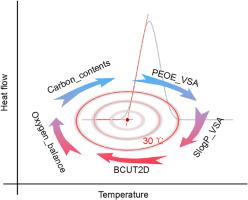Energetic Materials Frontiers Pub Date : 2023-09-16 , DOI: 10.1016/j.enmf.2023.09.004 Zhi-xiang Zhang , Yi-lin Cao , Chao Chen , Lin-yuan Wen , Yi-ding Ma , Bo-zhou Wang , Ying-zhe Liu

|
In this study, machine learning (ML)-assisted regression modeling was conducted to predict the thermal decomposition temperatures and explore the factors that correlate with the thermal stability of energetic materials (EMs). The modeling was performed based on a dataset consisting of 885 various compounds using linear and nonlinear algorithms. The tree-based models established demonstrated acceptable predictive abilities, yielding a low mean absolute error (MAE) of 31°C. By analyzing the dataset through hierarchical classification, this study insightfully identified the factors affecting EMs’ thermal decomposition temperatures, with the overall accuracy improved through targeted modeling. The SHapley Additive exPlanations (SHAP) analysis indicated that descriptors such as BCUT2D, PEOE_VSA, MolLog_P, and TPSA played a significant role, demonstrating that the thermal decomposition process is influenced by multiple factors relating to the composition, electron distribution, chemical bond properties, and substituent type of molecules. Additionally, descriptors such as Carbon_contents and Oxygen_Balance proposed for characterizing EMs showed strong linear correlations with thermal decomposition temperatures. The trends of their SHAP values indicated that the most suitable ranges of Carbon_contents and Oxygen_Balance were 0.2–0.35 and −65 to −55, respectively. Overall, the study shows the potential of ML models for decomposition temperature prediction of EMs and provides insights into the characteristics of molecular descriptors.
中文翻译:

机器学习辅助含能材料热分解温度定量预测及其热稳定性分析
在这项研究中,通过机器学习(ML)辅助回归建模来预测热分解温度并探索与含能材料(EM)热稳定性相关的因素。该建模是基于由 885 种不同化合物组成的数据集,使用线性和非线性算法进行的。建立的基于树的模型表现出可接受的预测能力,平均绝对误差 (MAE) 较低,为 31°C。通过对数据集进行层次分类分析,本研究深入地识别了影响EMs热分解温度的因素,并通过有针对性的建模提高了整体精度。SHapley Additive exPlanations (SHAP) 分析表明 BCUT2D、PEOE_VSA、MolLog_P 和 TPSA 等描述符发挥了重要作用,证明热分解过程受到与分子的组成、电子分布、化学键性质和取代基类型相关的多种因素的影响。此外,用于表征 EM 的 Carbon_contents 和 Oxygen_Balance 等描述符显示出与热分解温度的强线性相关性。其SHAP值的趋势表明,Carbon_contents和Oxygen_Balance的最合适范围分别为0.2-0.35和-65至-55。总体而言,该研究展示了机器学习模型在预测 EM 分解温度方面的潜力,并提供了对分子描述符特征的见解。和分子的取代基类型。此外,用于表征 EM 的 Carbon_contents 和 Oxygen_Balance 等描述符显示出与热分解温度的强线性相关性。其SHAP值的趋势表明,Carbon_contents和Oxygen_Balance的最合适范围分别为0.2-0.35和-65至-55。总体而言,该研究展示了机器学习模型在预测 EM 分解温度方面的潜力,并提供了对分子描述符特征的见解。和分子的取代基类型。此外,用于表征 EM 的 Carbon_contents 和 Oxygen_Balance 等描述符显示出与热分解温度的强线性相关性。其SHAP值的趋势表明,Carbon_contents和Oxygen_Balance的最合适范围分别为0.2-0.35和-65至-55。总体而言,该研究展示了机器学习模型在预测 EM 分解温度方面的潜力,并提供了对分子描述符特征的见解。其SHAP值的趋势表明,Carbon_contents和Oxygen_Balance的最合适范围分别为0.2-0.35和-65至-55。总体而言,该研究展示了机器学习模型在预测 EM 分解温度方面的潜力,并提供了对分子描述符特征的见解。其SHAP值的趋势表明,Carbon_contents和Oxygen_Balance的最合适范围分别为0.2-0.35和-65至-55。总体而言,该研究展示了机器学习模型在预测 EM 分解温度方面的潜力,并提供了对分子描述符特征的见解。



























 京公网安备 11010802027423号
京公网安备 11010802027423号